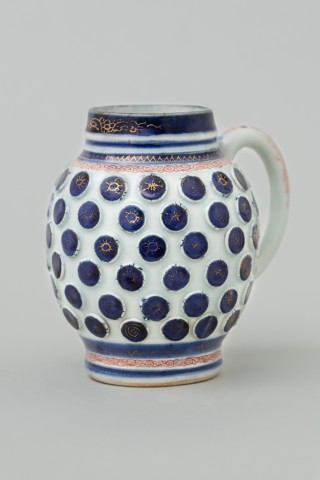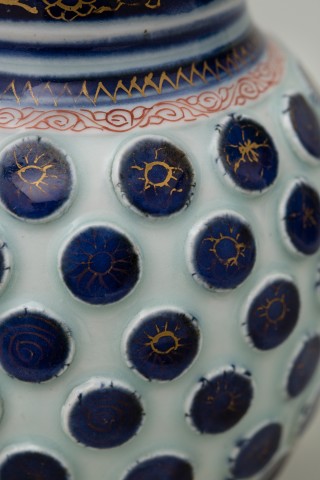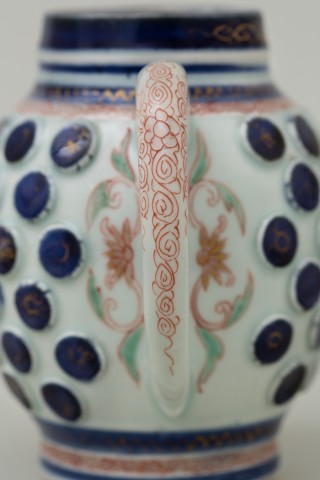AW99
Further images
Of European, probably German saltglazed stoneware example and shape, with a rounded barrel-like body, c-shaped handle and short moulded neck and foot, the body applied with bands of moulded dark blue bosses each painted with a gold outline of different types of flower-heads alternating with swirls, set above, around the neck a thin band of iron-red scroll-work and a further thin dark blue band with a zigzag motif in gold, and below, around the foot with two similar bands, the handle ornately decorated with a pattern of scroll-work and flower-heads in iron-red and with on each side of the handle a flower-head in gold with foliate leaves painted in a light green colour, the neck with a thin dark blue band and a slightly wider band in blue highlighted with flower-heads in gold, the base glazed.
Literature
For a similar example to our perfect one but in a different shape see Dr. C. J. A. Jörg, Interactions in Ceramics Oriental Porcelain and Delftware - Catalogue of an Exhibition January to February 1984, jointly presented by the Urban Council of Hong Kong and the Consulate General of the Netherlands, published by the Urban Council 1984, no. 81, p. 126, and catalogued as Japanese porcelain Arita, late 17th Century, Height 16 cm, Jörg writes, and we quote: "Tankards of Japanese porcelain in various sizes were much in demand and regularly ordered by the Dutch East India Company, starting in 1663. In order to obtain the desired - European - form, models were sent with the orders, mostly tankards of German stoneware. Most 17th Century Japanese tankards are painted in blue with semi-Chinese Transitional decoration or a more Japanese decoration with vertical panels and foliate scrolls (cf. cat. No. 61). They were provided with silver or pewter lids in the Netherlands. This example differs from the normal type, the decoration of discs indicating a literal copy of a German model. This is something only sporadically found in Japanese porcelain, so that this piece can with justice be called a rarity."
The British Museum has an almost identical tankard (museum number 2015,3013.1). They describe theirs as 'Hizen ware' produced at Arita in the late 17th or early 18th century (1680s - 1720s). They note that the form is 'based on a Rhenish Westerwald stoneware prototype'. For an example of what the 17th century Westerwald prototype may have looked like, albeit with the blue decoration inverted, see The Philadelphia Msueum of Art (accession number 1877-206). The example in the Rijksmuseum is catalogued under the Object Number AK-NM-2087.






